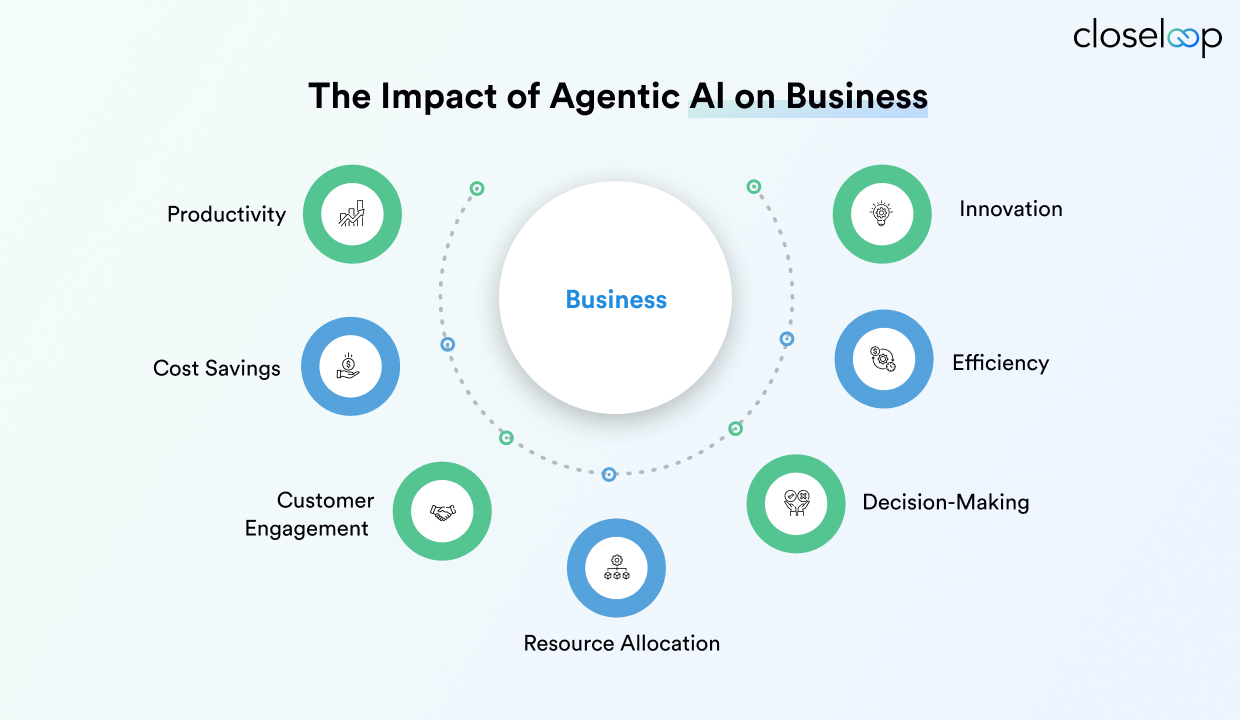Almost all companies today invest in AI, but just 1% believe they are at maturity. This gap between investment and maturity highlights the complexity of implementing truly autonomous AI systems that can act independently while delivering business value and accelerating Agentic AI adoption.
Over 40% of agentic AI projects will be cancelled by the end of 2027, due to escalating costs, unclear business value, or inadequate risk controls, reflecting common challenges in implementing Agentic AI. However, organisations that successfully navigate this implementation challenge stand to gain competitive advantages through intelligent automation that goes far beyond traditional AI applications, demonstrating Successful Agentic AI implementation.
Agentic AI is revolutionising business and could lead to a hybrid workforce, but policy-makers and society must ensure that it is developed responsibly, as noted by the World Economic Forum. This transformative potential makes it essential for business leaders to understand not just what agentic AI can do but how to implement Agentic AI successfully within their organisational context, including clear steps to adopt Agentic AI.
Key Takeaways
-
Ensure agentic AI implementation aligns with clear business objectives and delivers measurable value through carefully selected use cases, prioritising Agentic AI use cases in enterprises
-
Assess and develop technical infrastructure, cultural readiness, and human capabilities before beginning implementation, as part of an Agentic AI integration strategy
-
Implement comprehensive governance frameworks addressing ethics, security, and compliance requirements specific to autonomous AI systems, following best practices for implementing Agentic AI
-
Prepare workforce for human-AI collaboration through training, communication, and gradual adoption strategies, managing the organizational impact of Agentic AI
-
Establish monitoring and improvement processes that ensure sustained performance and adaptation to changing conditions, supporting Enterprise AI adoption
Understanding Agentic AI: Beyond Traditional Automation
Agentic AI represents a fundamental evolution from reactive AI systems to proactive, autonomous agents capable of independent decision-making and complex task execution in organizations. This technology transcends the limitations of conventional automation by introducing cognitive capabilities that mirror human reasoning and adaptability.
Unlike rule-based automation that follows predetermined scripts, agentic AI leverages advanced reasoning capabilities to analyse situations, consider multiple options, and make contextual decisions. These systems can adapt their behaviour based on new information, learn from outcomes, and continuously improve their performance without constant human intervention, enabling Implementing Agentic AI at scale.
The cognitive architecture of agentic AI enables complex problem-solving that involves multiple steps, decision points, and dynamic adjustments. This capability makes them particularly valuable for handling unpredictable scenarios, managing complex workflows, and optimising outcomes in real-time, supporting Agentic AI in organizations.
ALSO READ: Agentic AI vs Generative AI
Business Case for Agentic AI Implementation
The compelling business rationale for agentic AI extends beyond simple cost reduction or efficiency gains to encompass fundamental transformation of how organizations operate, compete, and create value, underscoring the benefits of Agentic AI in business.

Strategic Advantages and Competitive Benefits
Organizations implementing agentic AI gain advantages through enhanced operational agility, improved decision-making speed, and the ability to scale cognitive work without proportional increases in human resources, advancing enterprise AI adoption. These systems enable 24/7 operations across multiple time zones and markets without the constraints of human availability.
Agentic AI systems excel at handling complex, multi-variable optimization problems that would overwhelm traditional approaches. They can simultaneously consider numerous factors, constraints, and objectives while adapting to changing conditions in real-time. This capability is particularly valuable in dynamic markets where rapid response to opportunities and threats determines competitive success, illustrating real-world examples of Agentic AI.
The technology drives new business models and revenue streams by automating manual processes. It also delivers personalized customer experiences at scale and uncovers opportunities beyond human analysis, reinforcing successful Agentic AI implementation.
ROI Considerations and Value Creation
The return on investment for agentic AI implementations typically manifests across multiple dimensions: operational efficiency, revenue enhancement, risk reduction, and strategic capability development. Organizations report significant improvements in processing speed, accuracy, and consistency when agentic systems handle routine cognitive tasks, a core outcome of implementing Agentic AI.
Direct cost savings emerge from reduced manual effort, improved resource utilization, and decreased error rates. However, the strategic value often exceeds immediate cost reductions through enhanced decision-making capabilities, faster market response times, and improved customer satisfaction, showcasing the organizational impact of Agentic AI.
Long-term value creation includes organizational learning acceleration, capability development, and competitive positioning. Agentic AI systems continuously improve through experience, creating compound benefits that increase over time while building institutional knowledge and capability assets, informing the future of Agentic AI in organizations.
Organizational Readiness Assessment
Successful agentic AI implementation requires comprehensive organizational readiness across multiple dimensions, including technical infrastructure, human capabilities, cultural alignment, and governance frameworks, framed as clear steps to adopt Agentic AI.
Technical Infrastructure Requirements
Agentic AI systems demand robust technical foundations, including scalable computing resources, secure data architectures, and reliable integration capabilities. Organizations must evaluate their current infrastructure against the requirements for processing intensive AI workloads, managing large datasets, and supporting real-time decision-making, aligning with an Agentic AI integration strategy.
Cloud infrastructure typically provides the most flexible foundation for agentic AI implementations, offering elastic scaling, advanced security features, and access to specialized AI services. However, organizations must consider data residency requirements, latency constraints, and integration with existing systems when selecting deployment architectures to support enterprise AI adoption.
Data quality and accessibility represent critical success factors, as agentic AI systems require comprehensive, accurate, and timely information to make effective decisions. Organizations should assess their data management capabilities, identify improvement needs, and establish governance frameworks that ensure AI systems have access to high-quality information, reducing challenges in implementing Agentic AI.
Cultural and Organizational Readiness
As companies move from narrow AI to generative AI to agentic AI and multi-agentic AI, the complexity of the risk landscape ramps up sharply. This complexity requires organizational cultures that embrace change, experimentation, and continuous learning while maintaining appropriate risk management practices, a best practice for implementing Agentic AI.
Leadership commitment and vision-setting play crucial roles in creating organizational readiness for agentic AI. Leaders must articulate clear value propositions, establish implementation priorities, and demonstrate commitment to supporting the cultural changes necessary for successful agentic AI adoption.
Employee readiness involves both technical skills development and mindset shifts toward human-AI collaboration. Organizations should assess current capabilities, identify training needs, and develop programs that prepare staff to work effectively alongside autonomous AI systems, enabling successful Agentic AI implementation.
Implementation Framework and Methodology
A systematic approach to agentic AI implementation reduces risks, accelerates time-to-value, and increases the likelihood of sustainable success, capturing best practices for implementing Agentic AI. The framework should address strategic planning, pilot execution, scaling strategies, and continuous improvement processes.
Phase 1: Strategic Planning and Use Case Selection
Successful implementation begins with clear strategic alignment and careful use case selection that balances business impact with implementation feasibility. Organizations should identify specific problems or opportunities where agentic AI can deliver measurable value while building organizational confidence and capabilities, prioritising Agentic AI use cases in enterprises.
High-value use cases typically involve repetitive cognitive tasks, complex decision-making scenarios, or processes requiring 24/7 availability. Customer service, financial analysis, supply chain optimization, and regulatory compliance represent common starting points for agentic AI implementations, illustrating real-world examples of Agentic AI.
|
Implementation Phase |
Duration |
Key Activities |
Success Metrics |
|
Strategic Planning |
4-6 weeks |
Use case identification, stakeholder alignment, and resource planning |
Approved business case, defined success criteria |
|
Pilot Development |
8-12 weeks |
System development, integration, testing |
Functional system, performance benchmarks |
|
Limited Deployment |
4-8 weeks |
Controlled rollout, user training, and monitoring |
User adoption, performance validation |
|
Scaling and Optimization |
12-16 weeks |
Broader deployment, process optimization, capability expansion |
Business impact achievement, operational efficiency |
Phase 2: Technology Selection and Architecture Design
Technology selection for agentic AI implementation requires evaluation of multiple platforms, frameworks, and integration options based on organizational requirements, technical constraints, and strategic objectives. Organizations should consider factors including scalability, security, integration capabilities, vendor support, and total cost of ownership, as steps to adopt Agentic AI responsibly.
Leading agentic AI platforms offer different strengths and capabilities suited to various use cases and organizational contexts. Enterprise platforms typically provide comprehensive governance, security, and integration features, while specialized solutions can offer superior performance for specific applications, supporting an Agentic AI integration strategy.
The architecture design must address system integration, data flow, security controls, and scalability requirements. Organizations should design for flexibility and evolution, anticipating future expansion and capability enhancement needs while maintaining security and compliance standards, preparing for the future of Agentic AI in organizations.
Phase 3: Development and Testing
Agentic AI development requires iterative approaches that enable continuous learning, adaptation, and improvement. Agile development methodologies work well for AI projects, allowing teams to respond to insights, challenges, and opportunities that emerge during implementation, improving the odds of successful Agentic AI implementation.
Comprehensive testing protocols should address functional performance, integration reliability, security validation, and user experience evaluation. Testing should include edge cases, failure scenarios, and performance under various load conditions to ensure robust operation in production environments, minimising challenges in implementing Agentic AI.
User acceptance testing plays a crucial role in ensuring that agentic AI systems meet practical needs and integrate effectively with existing workflows. Organizations should involve end users throughout development to gather feedback, identify improvement opportunities, and build adoption readiness, supporting Enterprise AI adoption.
Risk Management and Governance
Existing AI risk programs need to evolve for organizations to move fast without breaking their brand and the people they impact, a best practice for implementing Agentic AI. Effective governance frameworks must address the unique challenges of autonomous AI systems while enabling innovation and value creation.
AI Ethics and Responsible Implementation
Ethical considerations for agentic AI extend beyond traditional norms to include questions of autonomy, accountability, and human oversight. Organizations must establish clear principles for AI behavior, decision-making boundaries, and human intervention protocols, grounded in Agentic AI in organizations.
Bias prevention and fairness considerations require ongoing monitoring and adjustment, as agentic AI systems can amplify biases present in training data or decision-making algorithms. Organizations should implement bias testing, diverse stakeholder input, and regular algorithmic auditing to ensure fair outcomes, part of best practices for implementing Agentic AI.
Transparency and explainability become particularly important for agentic AI systems that make autonomous decisions with business impact. Organizations should implement logging, decision tracking, and explanation capabilities that enable understanding and accountability for AI actions, supporting successful Agentic AI implementation.
Security and Risk Mitigation
Security frameworks for agentic AI must address unique risks, including autonomous system compromise, decision manipulation, and unintended consequences of AI actions. Access controls and authorization frameworks should implement the principle of least privilege while enabling AI systems to perform their intended functions effectively, aligning with steps to adopt Agentic AI securely. Organizations must balance security restrictions with functional requirements to ensure both protection and performance.
Incident response procedures should address AI-specific scenarios, including system malfunction, inappropriate decisions, and security breaches affecting autonomous systems. It is best to prepare for various failure modes and establish clear escalation and recovery protocols, reducing challenges in implementing Agentic AI.
ALSO READ: A guide to AI Security for Enterprise Leaders
Change Management and Human Integration
Successful agentic AI implementation requires effective change management that addresses human concerns, builds capabilities, and creates sustainable human-AI collaboration patterns, maximising the organizational impact of Agentic AI.
Workforce Transformation Strategies
Organizations should develop strategies that leverage human creativity, emotional intelligence, and complex problem-solving while enabling AI systems to handle routine cognitive tasks. Reskilling and upskilling programs should prepare employees for new roles that emphasise human-AI collaboration, oversight, and strategic decision-making, supporting Agentic AI adoption. Organizations should identify emerging skill requirements and develop training programs that build relevant capabilities.
Communication strategies should address employee concerns, explain the vision for human-AI collaboration, and demonstrate commitment to employee development and career growth. Transparent communication about AI capabilities, limitations, and intended applications helps build trust, advancing Enterprise AI adoption.
Training and Adoption Programs
Comprehensive training programs should address both technical skills and conceptual understanding of agentic AI capabilities and limitations. Users need to understand how to work effectively with autonomous systems, when to intervene, and how to interpret AI-generated insights and recommendations, as best practices for implementing Agentic AI.
Hands-on experience through pilot programs and gradual rollouts enables users to develop confidence and expertise with agentic AI systems. Organizations should provide supported learning environments where users can experiment and learn without business risk, building Successful Agentic AI implementation.
Feedback mechanisms and continuous improvement processes should capture user experiences, identify optimization opportunities, and refine human-AI integration and interaction patterns. Organizations should treat adoption as an ongoing process requiring attention and refinement, embedding steps to adopt Agentic AI.
Performance Monitoring and Optimization
Continuous monitoring and optimization ensure that agentic AI systems deliver expected value while adapting to changing conditions and requirements, a cornerstone of implementing Agentic AI. Effective monitoring addresses both technical performance and business impact metrics.
Key Performance Indicators and Metrics
Performance measurement for agentic AI should encompass multiple dimensions, including operational efficiency, decision quality, user satisfaction, and business impact. Organizations should establish baseline measurements and track improvement over time across relevant metrics, linking to the benefits of Agentic AI in business.
Business impact metrics should align with strategic objectives and measure the value delivered through agentic AI implementation. These might include cost reduction, revenue enhancement, customer satisfaction improvement, or risk mitigation achievements, supporting Enterprise AI adoption.
|
Metric Category |
Key Performance Indicators |
Measurement Frequency |
Target Performance |
|
Technical Performance |
System uptime, response time, and accuracy |
Real-time monitoring |
>99.9% uptime, <2s response |
|
Business Impact |
Cost reduction, revenue impact, efficiency gains |
Monthly reporting |
15-30% improvement targets |
|
User Experience |
Adoption rates, satisfaction scores, and usage patterns |
Quarterly surveys |
>80% satisfaction, 90% adoption |
|
Risk Management |
Incident frequency, compliance adherence, and security metrics |
Continuous monitoring |
Zero critical incidents |
Continuous Improvement Processes
Agentic AI systems require ongoing optimization to maintain effectiveness and adapt to changing conditions. Organizations should establish processes for regular performance review, capability enhancement, and strategic alignment assessment, future-proofing Agentic AI in organizations.
Machine learning model updates and retraining should be performed systematically based on new data, performance feedback, and changing business requirements. Organizations should maintain version control and testing protocols to ensure that updates improve rather than degrade performance, a best practice for implementing Agentic AI.
User feedback integration and process refinement should be ongoing activities that capture insights about system effectiveness, user experience, and optimization opportunities. Organizations should create mechanisms for collecting, analyzing, and acting on feedback from various stakeholders, closing the loop on steps to adopt Agentic AI.
Industry-Specific Implementation Considerations
Different industries face unique challenges and opportunities when implementing agentic AI, requiring tailored approaches that address specific regulatory requirements, operational constraints, and value creation opportunities, mapping Agentic AI use cases in enterprises.
Financial Services Applications
Financial institutions leverage agentic AI for fraud detection, risk assessment, algorithmic trading, and customer service automation. These applications require strict regulatory compliance, real-time performance, and high reliability standards, driving successful Agentic AI implementation.
Regulatory requirements in financial services demand comprehensive audit trails, explainable decisions, and human oversight capabilities. Agentic AI systems must be designed to meet these requirements while delivering operational benefits, minimising challenges in implementing Agentic AI.
Risk management considerations include model risk, operational risk, and regulatory compliance risk. Financial institutions should implement robust governance frameworks that address these risks while enabling innovation and competitive advantage, aligning with an Agentic AI integration strategy.
Healthcare and Life Sciences
Healthcare applications of agentic AI include clinical decision support, patient monitoring, drug discovery assistance, and administrative process automation. These implementations require careful consideration of patient safety, privacy protection, and regulatory compliance.
Clinical applications demand high accuracy, reliability, and integration with existing medical systems and workflows. Agentic AI systems must support rather than replace clinical judgment while providing valuable insights and assistance, supporting Enterprise AI adoption.
Privacy and security requirements in healthcare are particularly stringent, requiring comprehensive protection of patient information and compliance with regulations like HIPAA. Implementation approaches must address these requirements while enabling clinical value creation, ensuring successful Agentic AI implementation.
Manufacturing and Supply Chain
Manufacturing organizations use agentic AI for predictive maintenance, quality control, supply chain optimization, and production planning. These applications focus on operational efficiency, cost reduction, and quality improvement, highlighting the benefits of Agentic AI in business.
Industrial environments present unique challenges, including real-time requirements, integration with operational technology systems, and safety considerations. Agentic AI implementations must address these challenges while delivering operational benefits, reducing challenges in implementing Agentic AI.
Supply chain applications involve complex optimization problems with multiple variables, constraints, and objectives. Agentic AI systems can handle this complexity while adapting to disruptions and changing conditions in real-time, a hallmark of successful Agentic AI implementation.
Future Trends and Evolving Capabilities
The agentic AI landscape continues to evolve rapidly, with new capabilities, applications, and implementation approaches emerging regularly. Organizations should understand these trends to plan their long-term AI strategies effectively, anticipating the future of Agentic AI in organizations.
Emerging Technologies and Capabilities
Multi-agent systems represent a significant evolution in agentic AI, enabling multiple specialized agents to collaborate on complex tasks. These systems can handle more sophisticated problems while providing redundancy and specialized expertise, broadening Agentic AI use cases in enterprises.
Integration with Internet of Things (IoT) devices and edge computing expands the reach and capabilities of agentic AI systems, enabling real-time response to physical world conditions and events. This integration opens new application areas and value creation opportunities, supporting Enterprise AI adoption.
Advanced reasoning capabilities continue to improve, enabling agentic AI systems to handle more complex problems, consider more variables, and make more sophisticated decisions. These improvements expand the range of suitable applications and increase potential business value, strengthening Agentic AI in organizations.
Strategic Planning for AI Evolution
Organizations should develop long-term AI strategies that anticipate technological evolution while building foundational capabilities that support future enhancements. This approach ensures that current investments contribute to long-term competitive advantage, framing best practices for implementing Agentic AI.
Platform and architecture decisions should consider future expansion requirements, integration needs, and capability evolution. Organizations should design for flexibility and scalability while meeting current requirements effectively, as steps to adopt Agentic AI sustainably.
Capability development programs should prepare organizations for increasing AI sophistication while building the governance, risk management, and human capital foundations necessary for advanced AI applications, accelerating Agentic AI adoption.
Closeloop: Accelerating Agentic AI Success
With deep expertise in autonomous AI systems, enterprise integration, and organizational change management, Closeloop provides comprehensive AI integration services that bridge the gap between AI potential and practical business outcomes, focusing on Successful Agentic AI implementation.
Closeloop's proven methodology encompasses strategic planning, technical implementation, risk management, and change management support that accelerates time-to-value while building sustainable AI capabilities. Their cross-industry experience and technical expertise enable organizations to navigate the complexities of agentic AI implementation while avoiding common pitfalls that lead to project cancellation or underperformance, supporting an Agentic AI integration strategy.
By partnering with Closeloop, organizations gain access to specialized knowledge and proven frameworks that increase implementation success probability and deliver measurable business impact, advancing Enterprise AI adoption.
Conclusion: Embracing the Agentic AI Transformation
The implementation of agentic AI represents both an unprecedented opportunity and a complex challenge that requires careful planning, systematic execution, and ongoing optimization, capturing best practices for implementing Agentic AI. Success in agentic AI implementation demands more than technological capability it requires organizational transformation that encompasses culture, processes, skills, and governance frameworks. Organizations that implement systematically focusing on risk, change, and continuous improvement are better positioned for success, reflecting the benefits of Agentic AI in business. This approach helps them capture AI’s transformative benefits while avoiding common pitfalls.
As the technology continues to evolve and mature, early movers who build foundational capabilities and experience will enjoy sustained competitive advantages. The question for business leaders is not whether to embrace agentic AI, but how to implement Agentic AI effectively. They must also build the capabilities needed for long-term success, shaping the future of Agentic AI in organizations.
Start the Conversation
We collaborate with companies worldwide to design custom IT solutions, offer cutting-edge technical consultation, and seamlessly integrate business-changing systems.
Get in TouchUnlock the power of AI and Automation for your business with our no-cost workshop.
Join our team of experts to explore the transformative potential of intelligent automation. From understanding the latest trends to designing tailored solutions, our workshop provides personalized consultations, empowering you to drive growth and efficiency.
Go to Workshop DetailsExplore Our Latest Articles
Stay abreast of what’s trending in the world of technology with our well-researched and curated articles
View More InsightsCost Breakdown to Build a Custom Logistics Software: Complete Guide
Global logistics is transforming faster than ever. Real-time visibility, automation, and AI...
Logistics Software Development Guide: Types, Features, Industry Solutions & Benefits
The logistics and transportation industry is evolving faster than ever. It’s no longer...
From Hurdle to Success: Conquering the Top 5 Cloud Adoption Challenges
Cloud adoption continues to accelerate across enterprises, yet significant barriers persist....
Gen AI for HR: Scaling Impact and Redefining the Workplace
The human resources landscape stands at a critical inflection point. Generative AI in HR has...




